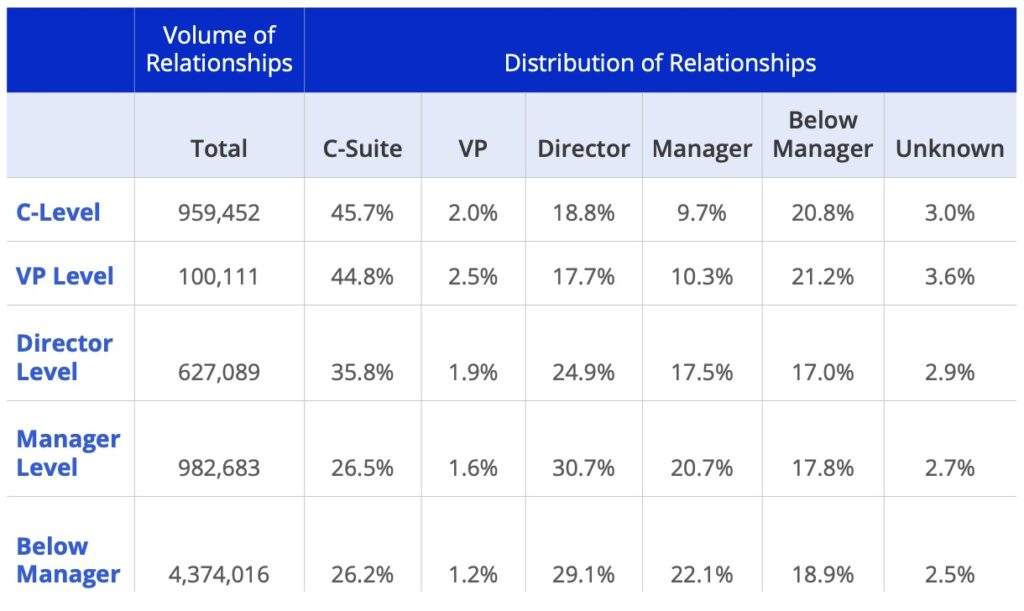In the legal industry, the evaluation of client relationship strength has long relied on conventional metrics such as billing data and anecdotal partner feedback. However, evolving dynamics in the industry such as the rise in M&A activity and lateral hires, require that law firms reevaluate their use of traditional benchmarks. Beyond the apparent financial transactions, the true health of a client relationship encompasses a holistic experience, ranging from the quality of service to overall client satisfaction with legal outcomes.
As the legal industry witnesses unprecedented shifts, it’s important that firms reassess their approach to client engagement, dispelling long-held assumptions and embracing a more comprehensive approach to client relationship management.
Beyond billing: rethinking client relationship metrics
Other than partner and client feedback, billing data is often viewed as a solid indicator of client relationship health. However, the reality extends far beyond the figures on an invoice. Client health pertains to the holistic client experience, from the quality of service provided to the client’s overall satisfaction with legal outcomes.
To truly understand client relationship strength, firms must emphasize the significance of using client health scores. These scores encapsulate a comprehensive view of the client’s journey, encompassing not only financial transactions but also the broader interactions across various teams and practice areas within the firm. In an era where clients demand a seamless, integrated approach to legal services, a myopic focus on billing history can lead to missed opportunities and client dissatisfaction.
The need for a solid data-foundation
Challenges in client retention arise when firms lack a thorough understanding of client needs, preferences, and historical interactions. Inconsistent data and a lack of standardized evaluation criteria can hinder quantitative approaches. When lawyers are reluctant to update CRMs, driven by a focus on billable hours, it inevitably leads to siloed data, making it impossible to keep pace with evolving client needs. Firms must prioritize accurate client insights, build a strong client data foundation, and promote cross-practice collaboration to reduce the risk of client attrition and maintain a competitive edge.
Breaking down the reliance on anecdotal feedback
In many firms, client engagement is measured through anecdotal partner feedback instead of data obtained through client surveys or similar methods. This reliance on partner perspectives may provide valuable qualitative insights, but it can also introduce subjectivity and potential biases into the evaluation process. A more comprehensive and data-driven approach that leverages surveys and objective metrics, can enhance the accuracy of engagement and satisfaction assessments.
Moreover, the determination of the breadth and depth of client relationships has traditionally been rooted in the analysis of firm billing data. While billing data is undeniably valuable, solely relying on it may overlook qualitative aspects of client interactions.
The depth vs. breadth misconception in client engagement
In the professional services industry, it’s often said that 80% of a firm’s revenue comes from 20% of its clients, underscoring the importance of nurturing strong client relationships. However, there exists a common misconception that these relationships primarily reside with individuals at the senior level within the organization. Diving deeper into this belief, a compelling study by the Harvard Business Review presents a different perspective, challenging the notion that billable hours alone are indicative of the depth of client connections.
Examining two lawyers with identical professional backgrounds and annual billed hours, the study revealed that the lawyer who strategically brought in six times more partners, including cross-functional collaborations, generated a staggering four times more client revenue than their counterpart, challenging the prevailing assumption that partners, with their seniority, hold the majority of influential client relationships.
Non-partners often engage with tactical employees within client organizations, contributing valuable relationships that go beyond traditional hierarchies. Introhive’s data reinforces this, revealing that while partners & directors may show a high percentage of senior relationships, more associate level attorneys possess a substantial volume of connections, contributing significant high-value contacts.

Professionals at the director level and below hold, on average, approximately 5.6 times more than C-level and VP-level employees combined.
This data underscores the importance of recognizing the breadth of relationships cultivated across different levels within the client organization, and the potential for diverse team members to contribute significantly to client engagement and overall firm revenue.
The impact of lateral moves in legal practices
2024 is already seeing a high volume of lateral hires, including the two new private equity M&A partners Freshfields landed for its transactions practice from Lathan & Watkins, three new partners joining Spencer Fane focused on patient litigate and trade secrets matters, and a number of IP lateral hires across Sidley Austin; Orrick Herrington & Sutcliffe; Sheppard, Mullin, Richter & Hampton; and Squire Patton Boggs. Firms are seeking growth to the point that they’re adding lateral hires across practices such as IP litigation and patent prosecution, despite the fact that these areas typically have lower profit margins than other higher-rate practices in litigation and corporate.
The surge in lateral hires within the legal industry in 2024 underscores the evolving landscape that law firms must navigate to maintain competitive edge and client satisfaction. While lateral hires bring fresh expertise and potential growth opportunities, they also pose challenges to client relationships, engagement, and retention. Clients often develop trust and rapport with specific attorneys over time, based on their understanding of the client’s needs and industry nuances. When key attorneys depart or new ones arrive, clients may experience uncertainty or apprehension about the continuity of service and expertise they receive. Law firms must proactively manage these transitions by facilitating smooth handovers, ensuring clear communication, and reaffirming their commitment to client satisfaction.
Moreover, frequent lateral movement can impact client engagement. Clients seek legal counsel from firms with deep industry knowledge and a stable team of experts who understand their unique challenges. The constant flux of attorneys may raise doubts about a firm’s stability or its ability to provide consistent, high-quality advice. To maintain client engagement, firms must invest in building enduring client relationships beyond individual attorneys, emphasizing the firm’s collective expertise, resources, and commitment to client success. Retention of clients becomes increasingly challenging in the face of relentless lateral movement. Clients may view frequent departures as a sign of instability or dissatisfaction within the firm, prompting them to explore alternative legal providers. To retain clients, firms must demonstrate their value proposition beyond individual attorneys, showcasing their comprehensive capabilities, track record of success, and unwavering dedication to client satisfaction. Implementing client-centric initiatives, such as tailored legal solutions, proactive communication, and personalized attention, can strengthen client loyalty and mitigate the risk of attrition.
Incentivizing succession planning and encouraging cross-selling
The adoption of succession planning and cross-selling can help firms shift away from the pitfalls surrounding the misconceptions discussed above to navigate the challenges posed by lateral hires and ensure the longevity of their client relationships.
Taking inspiration from the financial industry, incorporating financial incentives into succession planning is one approach to encouraging buy-in and removing resistance. This approach, which often involves using discretionary bonuses, can help incentivize attorneys to actively participate in transitioning clients to the next generation of lawyers within the firm. Marci Taylor, CEO of Mantra Legal, emphasizes the significance of cross-selling firm services as part of systematic succession planning. This not only leverages existing client relationships but also institutionalizes clients, increasing overall client stickiness.
Introducing a “billing” tier of credit further encourages professionals across practice areas to proactively engage in building and maintaining client relationships. By compensating attorneys for the personal work they contribute to client development, firms foster a culture of collaboration and client-centricity, ultimately strengthening client relationships and mitigating the risks associated with departures.
Next steps
Law firms must move beyond relying solely on billing history and anecdotal feedback to accurately assess client relationship strength and develop clients over the long-term. Dispelling misconceptions about client engagement and embracing proactive strategies like succession planning are vital for firms to navigate disruptions and thrive amid ongoing industry shifts and the increase in lateral moves among legal professionals.
Introhive’s AI-powered client relationship intelligence platform gives law firms deep client relationship insights, which they can use to adopt proactive strategies around engagement, retention, and account expansion. To learn more, book a demo.
Joseph Przybyla, Senior Account Executive at Introhive





